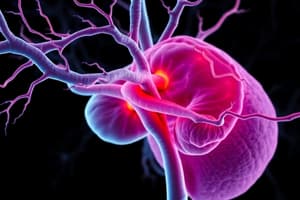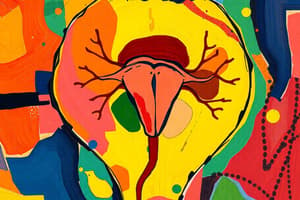Podcast
Questions and Answers
ما العامل الذي يحفز إفراز هرمون الفاسوبريسين؟
ما العامل الذي يحفز إفراز هرمون الفاسوبريسين؟
- انخفاض ضغط الدم
- ارتفاع ضغط الدم
- ارتفاع تركيز السوائل في الدم
- انخفاض تركيز السوائل في الدم (correct)
ما الدور الأساسي لهرمون الفاسوبريسين في الجسم؟
ما الدور الأساسي لهرمون الفاسوبريسين في الجسم؟
- تنظيم نشاط الجهاز الهضمي
- تنظيم دورة النوم والاستيقاظ
- تنظيم توازن الملح والبوتاسيوم
- تنظيم توازن السوائل وضغط الدم (correct)
ما المكان الذي يتم فيه تخزين هرمون الفاسوبريسين قبل إطلاقه؟
ما المكان الذي يتم فيه تخزين هرمون الفاسوبريسين قبل إطلاقه؟
- البنكرياس
- الغدة الكظرية الأمامية
- فص منبه فوقي
- الغدة الكظرية (correct)
كيف يتم تنظيم إفراز هرمون الفاسوبريسين بشكل عام في جسم الإنسان؟
كيف يتم تنظيم إفراز هرمون الفاسوبريسين بشكل عام في جسم الإنسان؟
ما الذي يقوم به العقدة العصبية الخلفية؟
ما الذي يقوم به العقدة العصبية الخلفية؟
ما هو العامل الرئيسي الذي يحدد إطلاق الأوكسيتوسين؟
ما هو العامل الرئيسي الذي يحدد إطلاق الأوكسيتوسين؟
كيف تُنظِّم آلية التغذية الراجعة سرعة إفراز هرمونات الفاسوبريسين والأوكسيتوسين؟
كيف تُنظِّم آلية التغذية الراجعة سرعة إفراز هرمونات الفاسوبريسين والأوكسيتوسين؟
ما هو دور العصبونات المستشعرة في التغذية الراجعة لهرمونات الأوكسيتوسين والفاسوبريسين؟
ما هو دور العصبونات المستشعرة في التغذية الراجعة لهرمونات الأوكسيتوسين والفاسوبريسين؟
ما هو دور فروع جهاز المخارج المؤدي إلى التغذية الراجعة؟
ما هو دور فروع جهاز المخارج المؤدي إلى التغذية الراجعة؟
كيف يؤثر نظام المخ-الغده نافذه ذات التأثير على إصدار هرمونات مثل الأوكسيتوسين؟
كيف يؤثر نظام المخ-الغده نافذه ذات التأثير على إصدار هرمونات مثل الأوكسيتوسين؟
Flashcards are hidden until you start studying
Study Notes
Control of Posterior Pituitary Secretion: A Deep Dive into Vasopressin, Oxytocin, and the Hypothalamus-Pituitary Connection
The posterior pituitary gland, a small organ nestled at the base of the brain, is a vital component of the endocrine system. Its primary functions revolve around two essential hormones: vasopressin (also known as antidiuretic hormone or ADH) and oxytocin. These hormones facilitate a range of critical physiological processes, and to maintain proper balance, they are regulated through intricate mechanisms involving the hypothalamus. Let's explore these mechanisms in more detail.
Vasopressin Regulation
Vasopressin is synthesized in the hypothalamus, specifically in the supraoptic and paraventricular nuclei, and then transported to the posterior pituitary gland, where it is stored and released into the circulation. Its primary role is to regulate water balance and blood pressure by promoting water reabsorption in the kidneys.
Vasopressin secretion is regulated by the following factors:
- Osmolality: High blood osmolality (high concentration of solutes) stimulates the release of vasopressin. Conversely, a decrease in osmolality suppresses its secretion.
- Blood pressure: Low blood pressure signals the release of vasopressin to help maintain blood pressure and prevent circulatory collapse.
- Volume-sensitive neurons: The posterior pituitary gland is innervated by sensory neurons that detect changes in blood volume, and these neurons communicate with hypothalamic neurons to regulate vasopressin release.
Oxytocin Release Triggers
Oxytocin, sometimes referred to as the "love hormone," is involved in social bonding, childbirth, and lactation. Like vasopressin, oxytocin is synthesized in the hypothalamus and then transferred to the posterior pituitary gland for secretion.
Oxytocin release is primarily regulated by:
- Stimuli during birth: Mechanical stretching of the cervix, vaginal walls, and nipples releases oxytocin, which stimulates uterine contractions and milk ejection during nursing.
- Stress and social bonding: Oxytocin release is enhanced during social interactions, increasing feelings of attachment and trust.
- Sexual activity: Oxytocin is released in response to sexual activity, contributing to feelings of pleasure and bonding.
Negative Feedback Mechanisms
Negative feedback mechanisms ensure that hormonal secretions are tightly regulated and do not exceed physiological requirements. Vasopressin and oxytocin secretion are regulated by negative feedback loops that involve:
- Osmoreceptors and baroreceptors: These sensors provide feedback about blood osmolality and blood pressure, respectively, to the hypothalamus, modulating vasopressin release.
- Neurohormonal feedback: Vasopressin and oxytocin act on target organs and tissues, such as the kidneys and uterus, to induce specific effects. For example, increased blood osmolality due to vasopressin action on the kidneys results in a decrease in vasopressin release through negative feedback.
Hypothalamus-Pituitary Connection
The hypothalamus, a component of the limbic system, serves as the primary regulator of the posterior pituitary gland. Hypothalamic neurons synthesize and release specific neurohormones (such as vasopressin and oxytocin) into the bloodstream via the axonal projections to the posterior pituitary gland.
Hypothalamic neurons are, in turn, regulated by a variety of inputs from the environment, including osmolality, blood pressure, and social interactions, ensuring appropriate and timely responses to maintain homeostasis.
In summary, the control of posterior pituitary secretion is a complex process that involves the hypothalamus, the synthesis and release of vasopressin and oxytocin, and the regulation of these hormones through negative feedback mechanisms. This intricate system ensures proper body function and health.
Studying That Suits You
Use AI to generate personalized quizzes and flashcards to suit your learning preferences.




